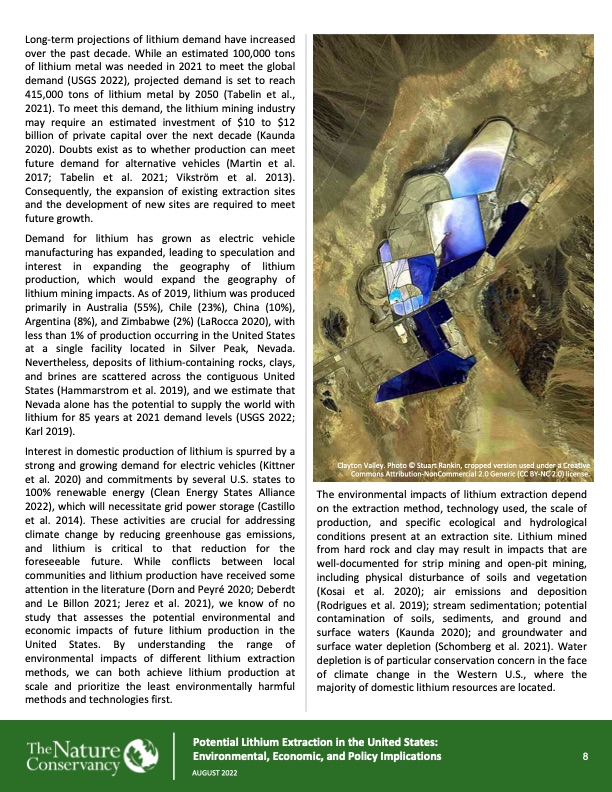
PDF Publication Title:
Text from PDF Page: 008
Long-term projections of lithium demand have increased over the past decade. While an estimated 100,000 tons of lithium metal was needed in 2021 to meet the global demand (USGS 2022), projected demand is set to reach 415,000 tons of lithium metal by 2050 (Tabelin et al., 2021). To meet this demand, the lithium mining industry may require an estimated investment of $10 to $12 billion of private capital over the next decade (Kaunda 2020). Doubts exist as to whether production can meet future demand for alternative vehicles (Martin et al. 2017; Tabelin et al. 2021; Vikström et al. 2013). Consequently, the expansion of existing extraction sites and the development of new sites are required to meet future growth. Demand for lithium has grown as electric vehicle manufacturing has expanded, leading to speculation and interest in expanding the geography of lithium production, which would expand the geography of lithium mining impacts. As of 2019, lithium was produced primarily in Australia (55%), Chile (23%), China (10%), Argentina (8%), and Zimbabwe (2%) (LaRocca 2020), with less than 1% of production occurring in the United States at a single facility located in Silver Peak, Nevada. Nevertheless, deposits of lithium-containing rocks, clays, and brines are scattered across the contiguous United States (Hammarstrom et al. 2019), and we estimate that Nevada alone has the potential to supply the world with lithium for 85 years at 2021 demand levels (USGS 2022; Karl 2019). Interest in domestic production of lithium is spurred by a strong and growing demand for electric vehicles (Kittner et al. 2020) and commitments by several U.S. states to 100% renewable energy (Clean Energy States Alliance 2022), which will necessitate grid power storage (Castillo et al. 2014). These activities are crucial for addressing climate change by reducing greenhouse gas emissions, and lithium is critical to that reduction for the foreseeable future. While conflicts between local communities and lithium production have received some attention in the literature (Dorn and Peyré 2020; Deberdt and Le Billon 2021; Jerez et al. 2021), we know of no study that assesses the potential environmental and economic impacts of future lithium production in the United States. By understanding the range of environmental impacts of different lithium extraction methods, we can both achieve lithium production at scale and prioritize the least environmentally harmful methods and technologies first. Clayton Valley. Photo © Stuart Rankin, cropped version used under a Creative Commons Attribution-NonCommercial 2.0 Generic (CC BY-NC 2.0) license. The environmental impacts of lithium extraction depend on the extraction method, technology used, the scale of production, and specific ecological and hydrological conditions present at an extraction site. Lithium mined from hard rock and clay may result in impacts that are well-documented for strip mining and open-pit mining, including physical disturbance of soils and vegetation (Kosai et al. 2020); air emissions and deposition (Rodrigues et al. 2019); stream sedimentation; potential contamination of soils, sediments, and ground and surface waters (Kaunda 2020); and groundwater and surface water depletion (Schomberg et al. 2021). Water depletion is of particular conservation concern in the face of climate change in the Western U.S., where the majority of domestic lithium resources are located. Potential Lithium Extraction in the United States: Environmental, Economic, and Policy Implications 8 AUGUST 2022PDF Image | Potential Lithium Extraction in the United States

PDF Search Title:
Potential Lithium Extraction in the United StatesOriginal File Name Searched:
Lithium_Report_FINAL.pdfDIY PDF Search: Google It | Yahoo | Bing
Product and Development Focus for Infinity Turbine
ORC Waste Heat Turbine and ORC System Build Plans: All turbine plans are $10,000 each. This allows you to build a system and then consider licensing for production after you have completed and tested a unit.Redox Flow Battery Technology: With the advent of the new USA tax credits for producing and selling batteries ($35/kW) we are focussing on a simple flow battery using shipping containers as the modular electrolyte storage units with tax credits up to $140,000 per system. Our main focus is on the salt battery. This battery can be used for both thermal and electrical storage applications. We call it the Cogeneration Battery or Cogen Battery. One project is converting salt (brine) based water conditioners to simultaneously produce power. In addition, there are many opportunities to extract Lithium from brine (salt lakes, groundwater, and producer water).Salt water or brine are huge sources for lithium. Most of the worlds lithium is acquired from a brine source. It's even in seawater in a low concentration. Brine is also a byproduct of huge powerplants, which can now use that as an electrolyte and a huge flow battery (which allows storage at the source).We welcome any business and equipment inquiries, as well as licensing our turbines for manufacturing.| CONTACT TEL: 608-238-6001 Email: greg@infinityturbine.com | RSS | AMP |